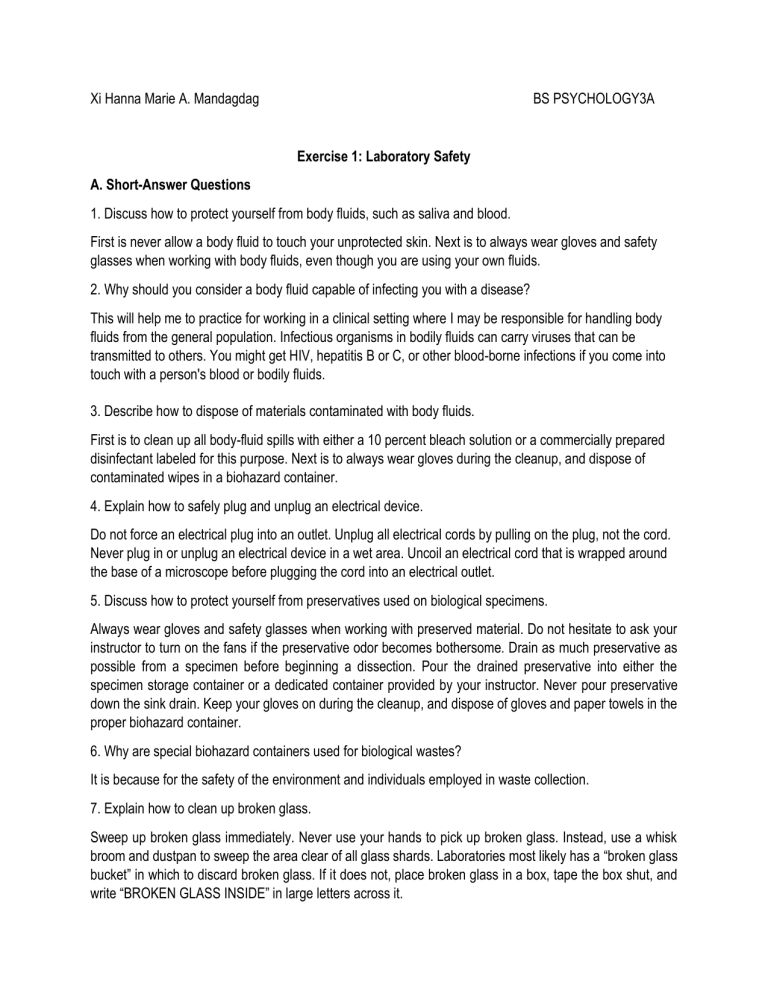Laboratory Safety Exercise: Psychology Student Guide
advertisement

Xi Hanna Marie A. Mandagdag BS PSYCHOLOGY3A Exercise 1: Laboratory Safety A. Short-Answer Questions 1. Discuss how to protect yourself from body fluids, such as saliva and blood. First is never allow a body fluid to touch your unprotected skin. Next is to always wear gloves and safety glasses when working with body fluids, even though you are using your own fluids. 2. Why should you consider a body fluid capable of infecting you with a disease? This will help me to practice for working in a clinical setting where I may be responsible for handling body fluids from the general population. Infectious organisms in bodily fluids can carry viruses that can be transmitted to others. You might get HIV, hepatitis B or C, or other blood-borne infections if you come into touch with a person's blood or bodily fluids. 3. Describe how to dispose of materials contaminated with body fluids. First is to clean up all body-fluid spills with either a 10 percent bleach solution or a commercially prepared disinfectant labeled for this purpose. Next is to always wear gloves during the cleanup, and dispose of contaminated wipes in a biohazard container. 4. Explain how to safely plug and unplug an electrical device. Do not force an electrical plug into an outlet. Unplug all electrical cords by pulling on the plug, not the cord. Never plug in or unplug an electrical device in a wet area. Uncoil an electrical cord that is wrapped around the base of a microscope before plugging the cord into an electrical outlet. 5. Discuss how to protect yourself from preservatives used on biological specimens. Always wear gloves and safety glasses when working with preserved material. Do not hesitate to ask your instructor to turn on the fans if the preservative odor becomes bothersome. Drain as much preservative as possible from a specimen before beginning a dissection. Pour the drained preservative into either the specimen storage container or a dedicated container provided by your instructor. Never pour preservative down the sink drain. Keep your gloves on during the cleanup, and dispose of gloves and paper towels in the proper biohazard container. 6. Why are special biohazard containers used for biological wastes? It is because for the safety of the environment and individuals employed in waste collection. 7. Explain how to clean up broken glass. Sweep up broken glass immediately. Never use your hands to pick up broken glass. Instead, use a whisk broom and dustpan to sweep the area clear of all glass shards. Laboratories most likely has a “broken glass bucket” in which to discard broken glass. If it does not, place broken glass in a box, tape the box shut, and write “BROKEN GLASS INSIDE” in large letters across it. 9. Your instructor informs you that a chemical is not dangerous. How should you dispose of the chemical? It will be diluted in water and poured down the drain. 10. What precautions should you take while using a centrifuge? It is important to keep all loose hair, clothing, and jewelry away from the instrument. Never open the safety lid while the centrifuge is on or spinning. Do not attempt to stop a spinning centrifuge with your hand. The instrument has an internal braking mechanism that stops it safely. 11. How are preservatives correctly discarded? Never pour preservative solutions down the sink drain. Dispose of all preserved specimens by wrapping them in a plastic bag filled with an absorbent material such as cat litter and placing the bag in a designated area for pickup by a hazardous-waste company. 12. Discuss how to safely measure and mix chemicals. When pouring out a volume of a solution kept in a large container, always pour the approximate amount required into a smaller beaker first and then pour from this beaker to fill your glassware with the solution. Attempting to pour from a large storage container directly into any glassware other than a beaker may result in spilled solution coming into contact with your skin and clothing. When mixing solutions, always add a chemical to water; never add water to the chemical. By adding the chemical to the water, you reduce the chance of a strong chemical reaction occurring.




